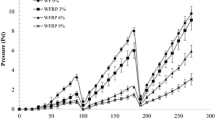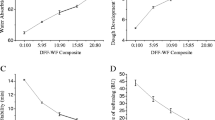Abstract
Theanine (T) and polyphenols (P) enriched fractions obtained from decaffeinated black tea dust by fractionation on a XAD resin, were incorporated into wheat bread formulation. The effect on dough properties and quality characteristics of supplemented breads was investigated. The development time and mixing resistance of dough was significantly increased by P fraction addition, indicating a stronger dough structure. P inhibited the Gram-positive bacteria, while E. coli was only inhibited by T fraction. Addition of P fraction provided an extension of bread shelf life up to 4 days as compared to control bread, while T fraction increased shelf life for 1 day. P fraction hindered the retrogradation of amylopectin which had no antifirming effect in bread. During storage, starch retrogradation in P bread crumbs was significantly retarded as compared with the control. P fraction produced darker, harder and coarser crumb structure and lower loaf volume. Crumb hardness was negatively correlated with bread volume (r = − 0.90, p < 0.05). The electronic nose system discriminated the bread odor based on the fraction used. Bread samples of different storage times were distinguished by e-nose with discrimination index above 90.




Similar content being viewed by others
References
Collar C (2016) In: Caballero B, Finglas PM, Toldrá F (eds) Encyclopedia of food and health. Elsevier, Oxford
Gray JA, Bemiller JN (2003) Bread staling: molecular basis and control. Compr Rev Food Sci Saf 2:1–21
Rayas-Duarte P, Mulvaney S (2012) In: Cauvain SP (ed) Breadmaking: Improving quality. Woodhead Publishing Limited, Cambridge
He H, Hoseney RC (1990) Changes in bread firmness and moisture during long-term storage. Cereal Chem 67:603–605
Galić K, Curić D, Gabrić D (2009) Shelf life of packaged bakery goods—a review. Crit Rev Food Sci 49:405–426
Caballero PA, Gómez M, Rosell CM (2007) Improvement of dough rheology, bread quality and bread shelf-life by enzymes combination. J Food Eng 81:42–53
Guarda A, Rosell CM, Benedito C, Galotto MJ (2004) Different hydrocolloids as bread improvers and antistaling agents. Food Hydrocoll 18:241–247
Sahari MA, Asgari S (2013) Effects of plants bioactive compounds on foods microbial spoilage and lipid oxidation. Food Science Technology 1:52–61
McKay DL, Blumberg JB (2002) The role of tea in human health: an update. J Am Coll Nutr 21:1–13
Sajilata MG, Bajaj PR, Singhal RS (2008) Tea polyphenols as nutraceuticals. Compr Rev Food Sci Saf 7:229–254
Sharma V, Rao LJ (2009) A thought on the biological activities of black tea. Crit Rev Food Sci 49:379–404
Ning J, Hou GG, Sun J, Wan X, Dubat A (2017) Effect of green tea powder on the quality attributes and antioxidant activity of whole-wheat flour pan bread. LWT Food Sci Technol 79:342–348
Zhu F, Sakulnak R, Wang S (2016) Effect of black tea on antioxidant, textural, and sensory properties of Chinese steamed bread. Food Chem 194:1217–1223
Wang R, Zhou W, Yu H-H, Chow W-F (2006) Effects of green tea extract on the quality of bread made from unfrozen and frozen dough processes. J Sci Food Agric 86:857–864
Wang H, Provan GJ, Helliwell K (2000) Tea flavonoid: their functions, utilisation and analysis. Trends Food Sci Technol 11:152–160
Culetu A, Héritier J, Andlauer W (2015) Valorization of theanine from decaffeinated tea dust in bakery functional food. Int J Food Sci Tech 50:413–420
Culetu A, Fernandez-Gomez B, Ullate M, del Castillo MD, Andlauer W (2016) Effect of theanine and polyphenols enriched fractions from decaffeinated tea dust on the formation of Maillard reaction products and sensory attributes of breads. Food Chem 197:14–23
CLSI (2015) Performance standards for antimicrobial susceptibility testing; twenty-fifth informational supplement (M100-S25). Clinical and Laboratory Standards Institute, Wayne
AACC Method 54–60.01 (2010) Determination of rheological behavior as a function of mixing and temperature increase in wheat flour and whole wheat meal by Mixolab, 11th edn. AACC International Approved Methods, St. Paul
AACC Method 10–05.01 (2010) Guidelines for measurement of volume by rapeseed displacement, 11th edn, AACC International Approved Methods, St. Paul
SR 91 (2007) Bread and fresh pastry products. Methods of analysis, (in Romanian)
AACC Method 44–15.02 (2010) Moisture–Air-oven methods, 11th edn, AACC International Approved Methods, St. Paul
Gonzales-Barron U, Butler F (2006) A comparison of seven thresholding techniques with the k-means clustering algorithm for measurement of bread crumb features by digital image analysis. J Food Eng 74:268–278
Bourne MC (1978) Texture profile analysis. Food Technol 32:62–66
Gerits LR, Pareyt B, Masure HG, Delcour JA (2015) A lipase based approach to understand the role of wheat endogenous lipids in bread crumb firmness evolution during storage. LWT Food Sci Technol 64:874–880
Alpha MOS (2002) Application note, Toulouse, France. http://www.alpha-mos.com. Accessed 17 Dec 2017
ISO 7932 (2004) Microbiology of food and animal feeding stuffs—Horizontal method for the enumeration of presumptive Bacillus cereus—Colony-count technique at 30 degrees C. International Standard Organization, Geneva, Switzerland, Technical Committee, ISO/TC 34/SC 9 [Corporate Author]
ISO 21527–1 (2008) Microbiology of food and animal feeding stuffs—Horizontal method for the enumeration of yeasts and moulds—Part 1: colony. count technique in products with water activity greater than 0,95. International Standard Organization, Geneva, Switzerland, Technical Committee, ISO/TC 34/SC 9 [Corporate Author]
Bansal S, Choudhary S, Sharma M, Kumar SS, Lohan S, Bhardwaj V, Syan N, Jyoti S (2013) Tea: a native source of antimicrobial agents. Food Res Int 53:568–584
Siddiqui MW, Sharangi AB, Singh JP, Thakur PK, Ayala-Zavala JF, Singh A, Dhua RS (2016) Antimicrobial properties of teas and their extracts in vitro. Crit Rev Food Sci 56:1428–1439
Sari F, Turkmen N, Polat G, Velioglu YS (2007) Total polyphenol, antioxidant and antibacterial activities of black mate tea. Food Sci Technol Res 13:265–269
Arora DJ, Kaur GJ, Kaur H (2009) Antibacterial activity of tea and coffee: their extracts and preparations. Int J Food Prop 12:286–294
Almajano MP, Carbó R, López Jiménez JA, Gordon MH (2008) Antioxidant and antimicrobial activities of tea infusions. Food Chem 108:55–63
Koksel H, Kahraman K, Sanal T, Ozay DS, Dubat A (2009) Potential utilization of Mixolab for quality evaluation of bread wheat genotypes. Cereal Chem 86:522–526
Ishii T, Moria T, Tanakab T, Mizuno D, Yamaji R, Kumazawa S, Nakayama T, Akagawa M (2008) Covalent modification of proteins by green tea polyphenol (−)-epigallocatechin-3-gallate through autoxidation. Free Radical Bio Med 45:1384–1394
Wang R, Zhou W (2004) Stability of tea catechins in the breadmaking process. J Agr Food Chem 52:8224–8229
Rosell CM, Collar C, Haros M (2007) Assessment of hydrocolloid effects on the thermo-mechanical properties of wheat using the Mixolab. Food Hydrocoll 21:452–462
Joye IJ, Lagrain B, Delcour JA (2009) Endogenous redox agents and enzymes that affect protein network formation during breadmaking—a review. J Cereal Sci 50:1–10
Zhu F, Cai Y-Z, Sun M, Corke H (2009) Effect of phytochemical extracts on the pasting, thermal, and gelling properties of wheat starch. Food Chem 112:919–923
Sivam AS, Sun-Waterhouse D, Waterhouse GIN, Quek S, Perera CO (2011) Physicochemical properties of bread dough and finished bread with added pectin fiber and phenolic antioxidants. J Food Sci 76:H97–H107
Stöllman U, Lundgren B (1987) Texture changes in white bread: effects of processing and storage. Cereal Chem 64:230–236
Xiao H, Lin Q, Liu G-Q, Yu F (2012) Evaluation of black tea polyphenol extract against the retrogradation of starches from various plant sources. Molecules 17:8147–8158
Xiao H, Lin Q, Liu G-Q, Wu Y, Wu W, Fu X (2013) Inhibitory effects of green tea polyphenols on the retrogradation of starches from different botanical sources. Food Bioprocess Technol 6:2177–2181
Zhu F (2015) Interactions between starch and phenolic compound. Trends Food Sci Technol 43:129–143
Ribotta PD, Le Bail A (2007) Thermo-physical assessment of bread during staling. LWT Food Sci Technol 40:879–884
Rogers DE, Zeleznak KJ, Lai CS, Hoseney RC (1988) Effect of native lipids, shortening, and bread moisture on bread firming. Cereal Chem 65:398–401
Romani S, Rodriguez-Estrada MT (2016) In: Rodríguez Méndez ML, Preedy VR (eds) Electronic Noses and Tongues in Food Science. Elsevier, London
Yashin AY, Nemzer BV, Combet E, Yashin YI (2015) Determination of the chemical composition of tea by chromatographic methods: A review. J Food Sci 4:56–88
Acknowledgements
This study was achieved through Nucleu Programme (PN 16 46), supported by the National Authority for Scientific Research and Innovation (ANCSI), contract 29N/2016. The authors wish to thank Dr. Alina Alexandra Dobre for assistance during the microbiological analysis. Authors also want to thank the Scientific Exchange Programme founded by Rectors’ Conference of the Swiss Universities (CRUS, Project code: 12.030).
Author information
Authors and Affiliations
Corresponding author
Ethics declarations
Conflict of interest
The authors declare that they have no conflict of interest.
Compliance with ethics requirements
This article does not contain any research involving human participants and/or animals.
Rights and permissions
About this article
Cite this article
Culetu, A., Duta, D.E. & Andlauer, W. Influence of black tea fractions addition on dough characteristics, textural properties and shelf life of wheat bread. Eur Food Res Technol 244, 1133–1145 (2018). https://doi.org/10.1007/s00217-018-3033-4
Received:
Revised:
Accepted:
Published:
Issue Date:
DOI: https://doi.org/10.1007/s00217-018-3033-4




